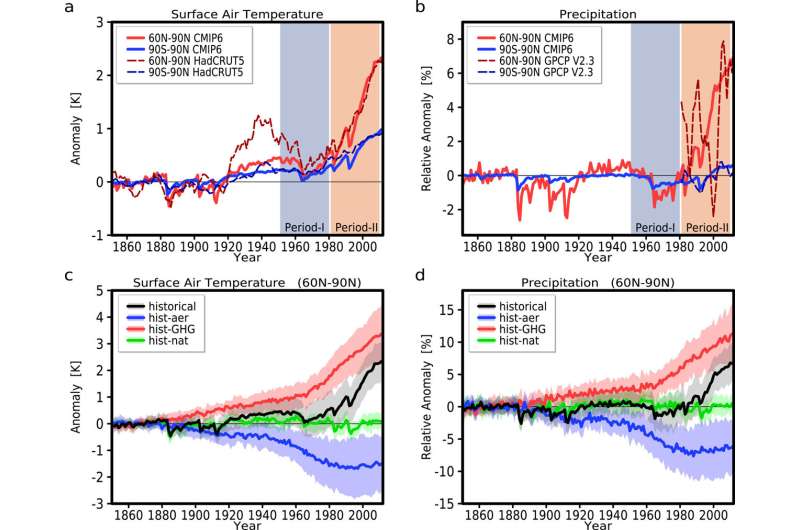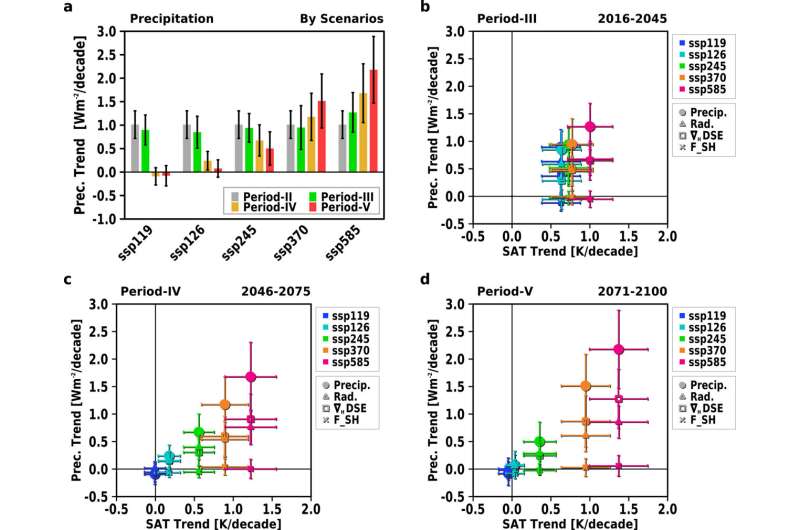April 8, 2024 feature
This article has been reviewed according to Science X's editorial process and policies. Editors have highlighted the following attributes while ensuring the content's credibility:
fact-checked
peer-reviewed publication
trusted source
proofread
Arctic precipitation rates to double as temperatures rise, finds new study

The Arctic is often cited for a plethora of impacts resulting from anthropogenic climate change, including glacier retreat and reductions in floating sea ice, meltwater incursions changing ocean salinity, as well as sea level rise to name but a few. As the region is warming three times faster than the global average annually, ice-albedo feedbacks will only exacerbate the issue further. This mechanism focuses on melting ice exposing more "dark" surface ocean and land to absorb heat to cause further melting, compared to the reflective nature of ice that would otherwise encourage cooling.
Precipitation on this icy continent predominantly falls in the form of snow, both in winter and summer, but occasional rain can occur with the transport of warmer air. While it is universally acknowledged that current low precipitation patterns are likely to change with global warming, the extent of the rate of increase is continuously being defined and is the focus of a new publication in Geophysical Research Letters.
Scientists at Japan's Meteorological Agency and National Institute of Polar Research have discovered a rapid increase in Arctic precipitation at twice the rate of rising global temperatures. The two factors are proportional: As Earth's temperature increases, so too will the rate of precipitation. This pattern was exhibited most prominently during northern hemisphere autumn months (September–December), compared to summer months (June–August).
To determine this, lead researcher Seiji Yukimoto and the team used Coupled Model Intercomparison Project Phase 6 models (supported by satellite and rain gauge data) to determine trends since the 1980s, with a clear strengthening of the temperature–precipitation link through this time. The CMIP6 model established an Arctic amplification factor of 2.7 for temperature, as a ratio of Arctic to global mean temperature trends, and 6.3 for Arctic to global precipitation trends.
In addition to these changes in greenhouse forcing, there was a coincident plateau in anthropogenic aerosol emissions (such as those originating from the combustion of fossil fuels). Prior to the 1980s, these aerosols had a dampening effect on the growth of greenhouse gas concentrations as they assisted cloud formation and the reflection of incoming solar radiation, therefore helping to keep the planet cooler. However, the models clearly show that since the 1950s, as anthropogenic aerosol concentrations declined (up to the 1980 plateau), greenhouse gas forcings increased.

Furthermore, a combination of increased radiative cooling (the emission of long-wave infrared radiation back out to space to balance the absorption of short-wave energy from the sun) and reduced poleward sensible heat transport (movement of warm water from the tropics to poles) due to smaller pole-equator temperature gradients have enhanced the Arctic precipitation pattern further.
Extrapolating this knowledge to examine future trends, up to 2045, the research team determined current precipitation patterns will continue, and beyond this to 2100 precipitation increases may be suppressed by reduced emissions and predicted declines in temperature increases.
This research highlights how continued mitigation of climate change is a significant factor in counterbalancing and reducing the current doubling in the Arctic amplification factor and the plethora of environmental impacts that it has both for its local inhabitants and the whole interconnected Earth system.
More information: S. Yukimoto et al, Factors Contributing to Historical and Future Trends in Arctic Precipitation, Geophysical Research Letters (2024). DOI: 10.1029/2023GL107467
Journal information: Geophysical Research Letters
© 2024 Science X Network



















